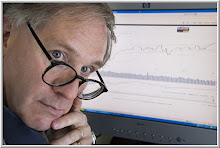 With the VIX plunging below 10, I thought it might be worthwhile to take a broad look at stock index volatility. Here I'm focusing on the size of the daily percentage price change by taking the 20 day moving average of the absolute value of open-to-close change. In the chart above covering 2003 to the present, we can see how the average size of the day's movement in the S&P 500 (SPY; blue) has hit bull market lows. The NASDAQ 100 (QQQQ; red) and the Russell 2000 (IWM; yellow) have remained above their volatility low points.
With the VIX plunging below 10, I thought it might be worthwhile to take a broad look at stock index volatility. Here I'm focusing on the size of the daily percentage price change by taking the 20 day moving average of the absolute value of open-to-close change. In the chart above covering 2003 to the present, we can see how the average size of the day's movement in the S&P 500 (SPY; blue) has hit bull market lows. The NASDAQ 100 (QQQQ; red) and the Russell 2000 (IWM; yellow) have remained above their volatility low points.The trend that is apparent is that the average size of the daily price change in SPY has been reduced by about 2/3 since 2003. The average open-to-close change in QQQQ has been cut in half over that same period. Notice, however, how IWM has retained far more of its daily price change volatility since 2003. Note also that the current average percentage price change in IWM is twice as large as in SPY. In relative terms, far more volatility has come out of the S&P 500 Index as out of the Russell 2000.
The volatility patterns of the three indices are highly correlated, as are their daily price changes. What this suggests is that, for short-term traders, the S&P 500 has been offering far less opportunity as a trading vehicle than either the NASDAQ 100 or the Russell 2000. For a given pattern that is valid across those markets, there has been more profit potential among the smaller caps and growth stocks than among the large caps.
Moral of the story? It's not just how you trade, but also *what* you trade that determines your P/L.




